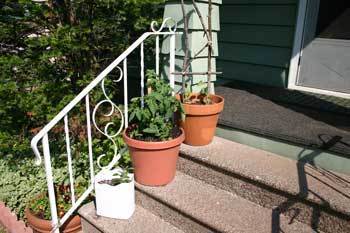
If your ability to garden is limited by a lack of space, a lack of accessibility or poor quality soil, then consider container gardening. All you need is a selection of plants, a few containers, the proper growing medium, and a sunny window, balcony, or porch and you're on your way to an excellent crop of vegetables or flowers.
The varieties of vegetables, flowers and herbs that thrive well in containers are nearly limitless. Vertical "climbers" like bush beans, peas, cucumbers, and tomatoes adapt to container conditions easily. Vegetables like lettuce, eggplants, onions, carrots, peppers, potatoes, even corn and squash work well, too. In general, small, quick maturing crops perform best, as do compact varieties of normally large plants like cabbage and melons.
The success of container grown plants is highly dependant on the quality of growing medium provided for them. Both air and water are needed to support proper root growth so container soil should be somewhat porous. The soils typically used in gardens tend to be too heavy for container gardening. They compact easily and don't offer good drainage. A packaged lightweight potting mix works well. Some of these are slightly acidic so amendments may be needed.
Containers can be purchased, built or recycled from items found around the house or garage. The most important consideration is choosing containers that best accommodate your plants. Onions and radishes will grow fine in aluminum cake pans. Root plants, like carrots, need a deeper container.
Plastic containers are lighter weight, but can become brittle in cold temperatures. Terra cotta containers are wonderfully porous and beautiful to look at, but are heavy, break easily and tend to dry out more quickly. Wooden containers made from cedar or redwood are more naturally rot-resistant than other woods. Metal containers heat up rapidly which can cause root damage, so consider using a clay or plastic pot as a liner.Other things to consider are color and drainage. Dark colored containers absorb more heat, sometimes too much, which can damage plant roots and make it difficult for them to thrive.
Make sure all your containers have adequate drainage on the bottom or sides near the bottom. Place them on brick feet or place a saucer under them to catch excess drainage or consider setting them on castors (before filling with heavy dirt!) to keep them easy to move.
Watering: Plants growing in containers dry out more quickly and need frequent watering. Because their roots can't dig deeper to find moisture, they need constant attention. Check them daily in warm temperatures and give them water until you see it draining from the bottom of the container. Keep newly sown seeds and transplants moist and water older plants when the top inch of soil becomes dry. Mulch containers with grass or gravel pebbles to reduce moisture loss between watering.
Fertilizing: It's necessary to supplement the growth of container plants with fertilizer due to nutrients leaching out from frequent watering. After the first 3-4 weeks of growth, add a diluted organic fertilizer like seaweed extract, fish emulsion, manure tea, or compost tea when watering. Do this every two weeks and adjust fertilizer levels as necessary according to how the plants respond.
Light: The amount of light your container needs will vary by crop. Most plants require at least 5-6 hours of full sun per day. This can be maximized with the addition of reflective materials (aluminum foil, glass marbles) placed around containers.

About The Author: Ellen Brown is an environmental writer and photographer and the owner of Sustainable Media, an environmental media company that specializes in helping businesses and organizations promote eco-friendly products and services.
Add your voice! Click below to comment. ThriftyFun is powered by your wisdom!

I live in the banana belt of Washington State. It gets over 100 here for about two weeks in August. Most containers can't tolerate that kind of heat, so find a cool spot in the heat of the summer for containers. I like the tomatoes cooked AFTER I pick them.
By Ardis Barnes

To keep dirt from draining out of your potted plants, place a coffee filter in the bottom of the flower pot, add gravel, or packing peanuts for added drainage, add dirt and plants. The coffee filter allows excess water to drain out, but keeps dirt in the pot. You'll never want to be without coffee filters again.
By Renee

BE CAUTIOUS with store bought potting soil. It has something in it that can make you very ill. I don't know what it is, but it is usually breathed in from the dust that flies around while handling it. At any rate USE A FACE MASK like Doctors use. they can be purchased at any pharmacy and I have seen them in Wal-Mart also.
By Ardis Barnes

I grew container tomatoes on patio, as they sprawled out, I used pieces of old pantyhose to tie and support them in place. This really works and best part is you can reuse the pantyhose strips.
By Cindy Miller

Use washed egg shells in the bottom of your plant pots. Also use them in cracks of your sidewalk, patio or driveway. It will kill slugs, ants other insects.
By Sandi G
My favorite container for indoor gardening is an old rusty 30-gallon trash can. I brought it in the house one autumn, hauled in buckets of good garden soil with rocks in the bottom, and used the inverted lid to catch water drips underneath. I dug up two or three chard plants from the garden and put them in my giant "pot." The chard produced all winter. Chard quiche, creamed chard. Until I inadvertently brought in a plant with aphids on it. They took over the chard. Lesson learned. The following winter I grew green onions and lettuce in it, and we had all we could use.
All this despite the fact that the window where it stood was not very sunny. That one pot probably was worth $20.00 or more in fresh food. Wish I had a really sunny window!
Legionaires(sp?) disease microorganisms have been found in potting mix - which if inhaled can lead to a serious atypical pneumonia. That's why a facemask is advised when using potting mix. The risk is small but better safe than sorry!
Regards
Jo

Make sure your plants that are in containers have good drainage. Add a few chunks of charcoal to keep the standing water fresh. Keep them out of the hot afternoon sun, the pots can over heat and cook the roots. Coffee filters can be the first thing to put in the pot to keep soil from eroding away. When the roots start growing out the bottom, it time to go one size up in pots.
By Ardis Barnes
Add your voice! Click below to comment. ThriftyFun is powered by your wisdom!